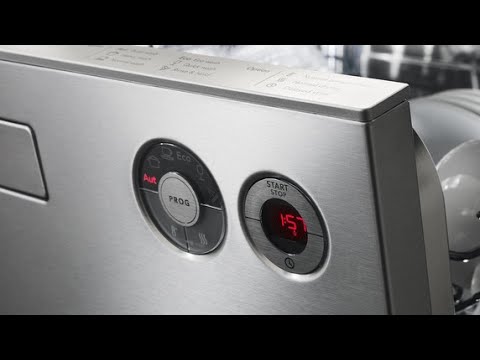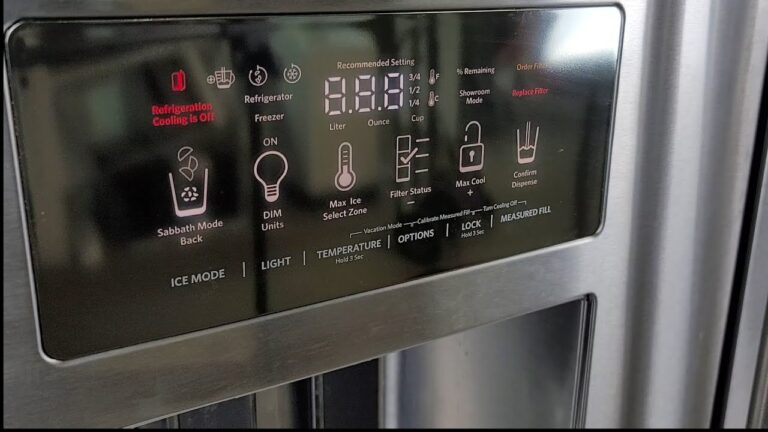Asko Dishwasher Troubleshooting: Fixing Common Issues
If your Asko dishwasher is not starting, it may be due to a defective pump and motor assembly. Check if power is reaching the circulation pump and motor, and if so, replace the assembly.

Reasons Why Your Asko Dishwasher Won’t Start
When your Asko dishwasher won’t start, it can be frustrating and inconvenient. There could be several reasons behind this issue, but one common cause is a problem with the circulation pump and motor assembly. In this section, we will explore two possible scenarios related to this issue: no power to the circulation pump and motor assembly, and a defective pump and motor assembly.
No Power To The Circulation Pump And Motor Assembly
If your Asko dishwasher is not receiving any power from the circulation pump and motor assembly, it won’t start. This lack of power could be caused by a variety of factors, such as:
- Faulty power supply: Check if the dishwasher is properly plugged in and that the power outlet is functioning correctly. Also, ensure that there are no tripped circuit breakers or blown fuses.
- Wiring issues: Inspect the wiring connections leading to the circulation pump and motor assembly. Look for any loose or damaged wires that may be preventing the flow of electricity.
- Defective control board: The control board is responsible for sending power to the various components of the dishwasher. If the control board is faulty, it may not be supplying power to the circulation pump and motor assembly.
Defective Dishwasher Pump And Motor Assembly
If power is reaching the circulation pump and motor assembly but your Asko dishwasher still won’t start, it is possible that the pump and motor assembly themselves are defective. This could be due to:
- Motor failure: Over time, the motor within the pump and motor assembly can wear out or become damaged. If the motor fails to function properly, the dishwasher won’t start.
- Pump blockage: A blockage in the pump impeller or drain hose can prevent the pump and motor assembly from operating. Inspect these components for any obstructions and remove them if necessary.
- Mechanical issues: There could be mechanical problems within the pump and motor assembly, such as a broken impeller or worn-out seals. These issues can prevent the dishwasher from starting and may require repairs or replacements.
If you’ve ruled out other potential causes and suspect that your Asko dishwasher’s pump and motor assembly are defective, it is recommended to seek professional assistance or contact Asko customer support for further troubleshooting or repair options.
How To Diagnose And Fix A Dishwasher That Won’t Start
If you’re facing the frustrating issue of a dishwasher that won’t start, there could be several possible causes. Before you call a professional for help, try troubleshooting the problem yourself using these steps. By checking the power supply, inspecting the door latch, checking the child safety lock, resetting the dishwasher, testing the door latch switch, and testing the timer and selector switch, you may be able to identify and resolve the issue without any outside assistance.
Check The Power Supply
The first step in troubleshooting a dishwasher that won’t start is to ensure that it is receiving power. Follow these steps to check the power supply:
- Verify that the dishwasher is plugged into a functioning power outlet.
- Check if the circuit breaker for the dishwasher has tripped. If it has, reset the breaker.
- Inspect the power cord for any damage or frayed wires. If any issues are found, it may need to be replaced.
Inspect The Door Latch
If the power supply is not the issue, the next step is to inspect the door latch. A faulty door latch can prevent the dishwasher from starting. Follow these steps to inspect the door latch:
- Open and close the dishwasher door firmly to ensure that the latch is properly engaged.
- Check if there is any debris or obstructions preventing the door from closing fully. Clean or remove any obstacles.
- Inspect the door latch mechanism for any signs of damage or wear. If any issues are found, the latch may need to be replaced.
Check The Child Safety Lock
Some dishwashers have a child safety lock feature that can prevent it from starting. If your dishwasher has this feature, ensure that it is turned off or deactivated in order to start the dishwasher.
Reset The Dishwasher
It’s possible that the dishwasher’s control panel may need to be reset. Follow these steps to reset the dishwasher:
- Turn off the dishwasher by unplugging it or flipping the circuit breaker.
- Wait for a few minutes, then restore power to the dishwasher.
- Attempt to start the dishwasher again.
Test The Door Latch Switch
The door latch switch is responsible for detecting whether the dishwasher door is closed or open. A faulty door latch switch can prevent the dishwasher from starting. Follow these steps to test the door latch switch:
- Locate the door latch switch, which is usually located near the door latch mechanism.
- Carefully disconnect the wires from the switch.
- Using a multimeter, test the continuity of the switch by touching the multimeter probes to the switch terminals.
- If the switch does not show continuity when the door is closed, it may need to be replaced.
Test The Timer
The timer in the dishwasher controls the various cycles and functions. If the timer is faulty, it can prevent the dishwasher from starting. Follow these steps to test the timer:
- Locate the timer, usually found on the control panel of the dishwasher.
- Carefully disconnect the wires from the timer.
- Using a multimeter, test the continuity of the timer by touching the multimeter probes to the timer terminals.
- If the timer does not show continuity when it is supposed to be running, it may need to be replaced.
Test The Selector Switch
The selector switch allows you to choose different dishwasher cycles and functions. If the selector switch is faulty, it can prevent the dishwasher from starting. Follow these steps to test the selector switch:
- Locate the selector switch, usually found on the control panel of the dishwasher.
- Carefully disconnect the wires from the switch.
- Using a multimeter, test the continuity of the switch by touching the multimeter probes to the switch terminals.
- If the switch does not show continuity in the selected positions, it may need to be replaced.
By following these troubleshooting steps, you can diagnose and potentially fix a dishwasher that won’t start. However, if the issue persists or you are unsure about performing any of these steps, it is always recommended to consult a professional for assistance.
Common Problems That Can Cause An Asko Dishwasher To Not Work
One of the most frustrating experiences in the kitchen is when your dishwasher refuses to start. Before you call for professional help, there are a few common problems that you can troubleshoot yourself. In this section, we will explore three possible reasons why your Asko dishwasher might not be working: a broken drive motor, faulty wash arms, or a stuck detergent door.
Broken Drive Motor
A broken drive motor is a common cause for a dishwasher to not work. If the dishwasher appears to have power but the motor isn’t running, it could be due to a malfunction in the motor. To determine if the drive motor is the issue, follow these steps:
- Turn off the power to the dishwasher.
- Inspect the drive motor for any visible signs of damage or wear.
- If there are no visible issues, use a multimeter to test the motor for continuity.
- If the motor doesn’t show continuity, it is likely broken and needs to be replaced.
Faulty Wash Arms
Another common problem that can cause your Asko dishwasher to not work is faulty wash arms. The wash arms are responsible for distributing water and detergent throughout the dishwasher during the wash cycle. If the wash arms are clogged or damaged, the dishwasher may not be able to clean your dishes effectively. To troubleshoot this issue, follow these steps:
- Inspect the wash arms for any visible signs of debris or damage.
- Clean the wash arms thoroughly, removing any obstructions.
- Check the wash arm bearings for any signs of wear and tear. If necessary, replace them.
- Run a test cycle to see if the dishwasher is now working properly.
Stuck Detergent Door
A detergent door that’s stuck closed can also prevent your Asko dishwasher from working. When the detergent door doesn’t open during the wash cycle, the dishes won’t receive proper cleaning. To troubleshoot this issue, follow these steps:
- Inspect the detergent door for any visible blockages or obstructions.
- Use a small tool, such as a toothpick, to gently pry open the detergent door.
- Check the spring and latch mechanism to ensure they are functioning properly.
- If the spring or latch is broken, replace them.
By addressing these common problems, you may be able to fix your Asko dishwasher without the need for professional assistance. However, if these troubleshooting steps do not resolve the issue, it’s best to consult a professional technician to diagnose and repair your dishwasher.
How To Troubleshoot And Repair An Asko Dishwasher
Identify Common Problems
If you’re facing issues with your Asko dishwasher, it can be frustrating trying to figure out what’s causing the problem. Luckily, many common dishwasher problems have simple solutions. By identifying the common problems, you can troubleshoot and potentially repair your Asko dishwasher without the need for a professional.
Here are some of the most common problems you might encounter with your Asko dishwasher:
| Problem | Possible Cause |
|---|---|
| No water | Blocked water inlet valve or clogged filter |
| Not starting | Faulty door latch or door switch |
| Touchpad not working | A defective control panel or a faulty touchpad |
| The display is not working | Power supply issues or a malfunctioning control board |
Diy Fixes And Solutions
Before you reach out for professional help, here are some DIY fixes and solutions you can try to resolve the common problems with your Asko dishwasher:
- For the problem of no water, check if the water inlet valve is blocked or if the filter is clogged. Cleaning or replacing these parts can often solve the issue.
- If your dishwasher is not starting, it could be due to a faulty door latch or door switch. Inspect these components and replace them if necessary.
- When dealing with a touchpad not working, it might be caused by a defective control panel or the touchpad itself. Try resetting the touchpad or replacing the control panel.
- In case the display is not working, check the power supply and ensure it is properly connected. If the power supply is fine, then the issue might be with a malfunctioning control board. Replacing the control board should fix the problem.
Remember, always refer to your Asko dishwasher’s manual for specific troubleshooting steps and instructions. Additionally, make sure to turn off the power before attempting any repairs or replacements. If you’re unsure or uncomfortable with DIY fixes, it’s best to seek professional help.
Hiring A Professional For Repairs
In some cases, DIY fixes might not be sufficient to resolve your Asko dishwasher problems. If you’re unable to fix the issue on your own or if you’re not confident in your repair skills, it’s recommended to hire a professional for repairs.
A professional dishwasher repair service will have the expertise and knowledge to diagnose and fix complex problems with your Asko dishwasher. They will also have access to specialized tools and replacement parts, ensuring a proper and long-lasting repair.
When hiring a professional for repairs, consider the following:
- Choose a reputable and experienced appliance repair company that specializes in dishwasher repairs.
- Read customer reviews and check their credentials to ensure they are reliable and trustworthy.
- Get multiple quotes from different repair services to compare prices and services.
- Ask about warranties or guarantees on their repair work to ensure peace of mind.
By following these steps, you can ensure that your Asko dishwasher receives the professional care it needs to get back to its optimal performance.
Life Expectancy Of An Asko Dishwasher
Factors That Affect The Lifespan Of A Dishwasher
The lifespan of a dishwasher can be influenced by various factors. Understanding these factors can help you make informed decisions when it comes to purchasing and maintaining your Asko dishwasher.
1. Quality of materials and construction
One of the key factors that influences the lifespan of a dishwasher is the quality of materials used in its construction. High-quality materials are more durable and resistant to wear and tear, increasing the lifespan of the appliance. Asko dishwashers are known for their exceptional build quality, using sturdy materials that can withstand the test of time.
2. Frequency of use
The frequency of use also plays a role in determining the lifespan of a dishwasher. Generally, the more often a dishwasher is used, the sooner it may show signs of wear and tear. Asko dishwashers are designed to handle frequent use, with robust components and advanced technologies that contribute to their long-lasting performance.
3. Maintenance and care
Proper maintenance and care can significantly extend the lifespan of your dishwasher. Regularly cleaning the filters, removing food debris, and checking for any potential issues can help prevent malfunctions and ensure optimal performance. By following the manufacturer’s recommended maintenance guidelines, you can keep your Asko dishwasher running smoothly for years to come.
4. Water quality
The quality of water in your area can also impact the lifespan of your dishwasher. Hard water with high mineral content can cause mineral deposits and buildup, affecting the efficiency of the appliance over time. Asko dishwashers are designed to handle various water conditions, but it is still recommended to periodically descale and clean the dishwasher to prevent any potential issues.
5. Proper installation
Lastly, having your dishwasher installed correctly is crucial for its long-term performance. Improper installation can lead to leaks, electrical issues, or other problems that may shorten the lifespan of the appliance. It is advisable to hire a professional installer to ensure your Asko dishwasher is installed according to the manufacturer’s specifications.
Comparing Asko To Other Dishwasher Brands
When comparing Asko dishwashers to other brands, it’s essential to consider the factors mentioned above. Asko is renowned for its commitment to quality, using premium materials, and incorporating innovative technologies into its dishwashers. This results in a longer lifespan and reliable performance.
In comparison to other dishwasher brands, Asko stands out for its durability, efficiency, and superior cleaning capabilities. Their dishwashers are designed with user convenience in mind, offering features such as adjustable racks, customizable wash cycles, and quiet operation. By investing in an Asko dishwasher, you can expect a long-lasting appliance that delivers exceptional results and makes your daily dishwashing tasks a breeze.
Frequently Asked Questions
Why Is My Asko Dishwasher Not Working?
If your Asko dishwasher is not working, it could be due to a defective pump and motor assembly. Check if power is reaching the circulation pump and motor. If it is, but the dishwasher still won’t run, you may need to replace the pump and motor assembly.
What Is The Life Expectancy Of An Asko Dishwasher?
The life expectancy of an Asko dishwasher typically varies depending on usage, maintenance, and other factors. However, on average, an Asko dishwasher can last anywhere from 10 to 15 years with proper care and regular servicing.
How Do You Diagnose A Dishwasher Problem?
To diagnose a dishwasher problem: 1. Check the power supply. 2. Inspect the door latch and child safety lock. 3. Reset the dishwasher and turn off the power before disassembling. 4. Test the door latch switch, timer, and selector switch. 5.
If the dishwasher still won’t start, it may be a defective pump and motor assembly that needs replacing.
Why would my dishwasher not work?
If your dishwasher is not working, it could be due to a defective pump and motor assembly. Check if power is reaching the circulation pump and motor. If power is present but the dishwasher still won’t run, you may need to replace the pump and motor assembly.
Why Won’t My Asko Dishwasher Start?
If your Asko dishwasher won’t start, it could be due to a defective pump and motor assembly. Ensure that power is reaching the circulation pump and motor, and if it is, consider replacing the assembly.
Conclusion
Troubleshooting an Asko dishwasher can be done effectively by following a few steps. Ensure that power is reaching the circulation pump and motor, and if not, consider replacing them. Diagnosing other potential issues, such as a broken drive motor or faulty wash arms, is also important.
Hiring a professional or attempting repairs yourself can help resolve any problems preventing your dishwasher from starting. By following these guidelines, you can have your Asko dishwasher up and running again in no time.





